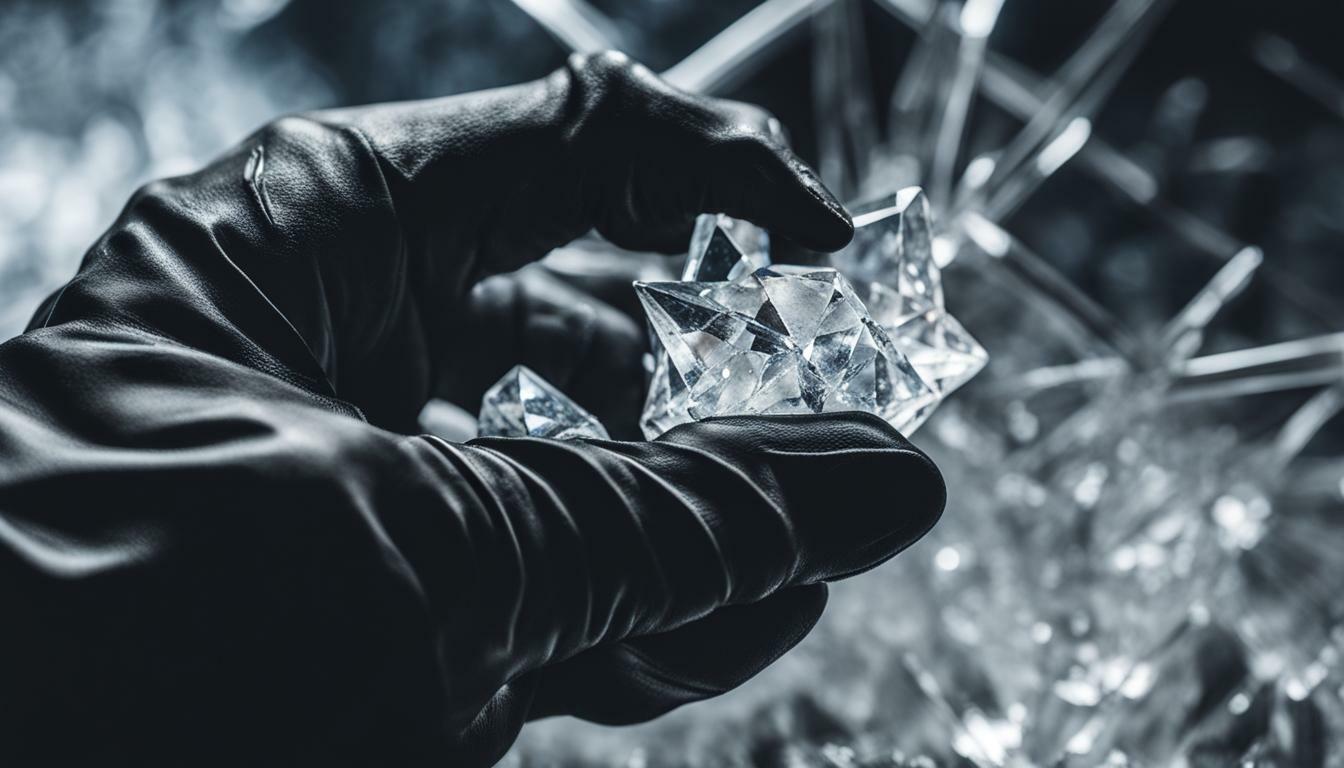Breaking crystals into smaller pieces is a common practice for making jewelry or using crystals in various crafts. It is generally okay to break crystals, as it does not affect their energy or properties. Quartz crystals can be split by hitting them with a rock hammer, while amethyst clusters can be broken to obtain the desired size of shards. It is possible to sand down quartz to achieve a smoother finish. When a crystal breaks, it can be given as a gift, used as decor, or even glued back together if the damage is minimal. In the case of making resin pendants, breaking larger crystals into smaller pieces can be done using a chisel or an awl. The size of the crystal does not impact its energetic properties. However, care should be taken to handle crystals gently to avoid chipping or cracking.
Key Takeaways:
- Breaking crystals into smaller pieces is commonly done for jewelry making and crafts.
- Quartz crystals can be split with a rock hammer, while amethyst clusters can be broken to obtain shards.
- Sanding down quartz can result in a smoother finish.
- Broken crystals can still be used as gifts, decor, or even glued back together.
- When making resin pendants, a chisel or awl can be used to break larger crystals into smaller pieces.
Understanding Crystal Properties and Safety Precautions
Before you begin breaking crystals, it’s important to have a basic understanding of crystal properties and take necessary safety precautions. Crystal fragmentation can be a delicate process, and by being aware of certain factors, you can ensure a successful and safe experience.
Firstly, it’s important to consider the crystal’s inherent properties. Different types of crystals have varying levels of hardness and structural integrity, which can impact the way they break. For example, quartz crystals are relatively brittle and can be split by applying pressure with a rock hammer. On the other hand, amethyst clusters may require careful breaking to obtain the desired size of shards.
When handling crystals, it is essential to prioritize safety. It is recommended to wear protective gear such as safety goggles and gloves to prevent any injuries. It’s also a good idea to work in a well-ventilated area to avoid inhaling any dust or debris that may be released during the breaking process.
Crystal Breaking Techniques
When breaking crystals, there are various methods you can employ depending on the type and size of the crystal. Here are a few commonly used techniques:
- Rock Hammer: This tool is ideal for splitting quartz crystals. Gently strike the crystal with the rock hammer along its natural fractures to break it into smaller pieces.
- Chisel: Used when making resin pendants, a chisel can be used to break larger crystals into smaller, manageable pieces. Place the chisel on the crystal’s surface and strike it carefully with a hammer, applying controlled force to obtain the desired size of shards.
- Awl: Similar to a chisel, an awl can be used to create fractures in the crystal. Place the tip of the awl on the desired breaking point and tap it gently with a hammer, gradually increasing the force until the crystal splits.
After breaking crystals, you may want to finish the broken pieces to achieve a desired appearance or smoothness. Sanding down quartz crystals using fine-grit sandpaper can help achieve a smoother finish. However, it’s important to handle the crystals gently during this process to avoid further damage.
| Summary: |
|---|
| Breaking crystals into smaller pieces is a common practice for jewelry making and various crafts. Understanding crystal properties and taking safety precautions are vital before starting the process. Different crystals require specific techniques for breaking, such as using a rock hammer for quartz and employing a chisel or an awl for resin pendants. Safety goggles, gloves, and a well-ventilated area should be utilized for protection. After breaking, finishing broken crystal pieces can be achieved through sanding with fine-grit sandpaper. Remember to handle crystals gently to avoid further damage. |
Breaking Techniques for Different Types of Crystals
Different types of crystals require specific techniques for breaking them into smaller pieces. Whether you’re looking to create your own crystal jewelry or need smaller crystal shards for a craft project, understanding how to break different crystals is crucial. Here are some methods for breaking crystals: 1. Quartz Crystals: Quartz crystals can be split by hitting them with a rock hammer. Place the crystal on a sturdy surface and carefully aim for the desired breaking point. Gently strike the crystal with the hammer, applying consistent force until it splits into smaller pieces. Remember to wear safety goggles and work in a well-ventilated area. 2. Amethyst Clusters: Amethyst clusters are beautiful and can be broken to obtain the desired size of shards. To do this, place the cluster on a soft cloth or towel to protect it. Use a hammer or mallet to carefully strike the amethyst at the desired breaking point. Start with light taps and gradually increase the force until it breaks into smaller pieces. 3. Sanding Quartz: If you want a smoother finish on your quartz pieces, sanding can be done. Use sandpaper or a sanding block with a fine grit to gently sand down the edges of the broken quartz. This will help create a polished and professional look for your crystal creations. Remember, when breaking crystals, it’s important to handle them with care. Avoid using excessive force or striking the crystals too hard, as this can result in unwanted damage. Additionally, always wear protective gear such as safety goggles and work in a well-ventilated area to ensure your safety.| Type of Crystal | Breaking Technique |
|---|---|
| Quartz | Splitting with a rock hammer |
| Amethyst | Breaking clusters with a hammer |
| Quartz | Sanding for a smoother finish |
Tools and Equipment for Breaking Crystals
Having the right tools and equipment is crucial for breaking crystals into smaller pieces. Whether you are a jewelry maker or a crystal enthusiast, there are a few essential items you’ll need to successfully break crystals and achieve your desired results.
One of the most common tools used for breaking crystals is a rock hammer. This heavy-duty hammer is specifically designed for breaking and splitting rocks and minerals. With its sharp chisel edge, it allows you to strike crystals with precision, creating clean breaks. It’s important to choose a rock hammer that suits your strength and comfort, as you’ll be using it to apply force to the crystals.
In addition to a rock hammer, you may also need a chisel and an awl. These tools are especially handy when breaking larger crystals into smaller pieces. The chisel, with its flat blade, can be used to carefully chip away at the crystal, while the awl, with its pointed tip, can be used to create cracks or separate sections. These tools are versatile and can be adjusted to fit your specific needs.
To ensure your safety while breaking crystals, it’s recommended to wear protective gear such as safety goggles and gloves. This will protect your eyes from flying debris and your hands from potential injuries. Remember to work in a well-ventilated area and on a stable surface to minimize any accidents or damage.
| Tools | Description |
|---|---|
| Rock Hammer | A heavy-duty hammer designed for breaking and splitting rocks and minerals. |
| Chisel | A tool with a flat blade used to carefully chip away at crystals. |
| Awl | A tool with a pointed tip used to create cracks or separate sections of crystals. |
| Safety Goggles | Protective eyewear to shield your eyes from flying debris. |
| Gloves | Protective gloves to keep your hands safe from potential injuries. |
With the right tools and equipment at your disposal, you’ll be able to break crystals into smaller pieces with precision and ease. Remember to handle crystals gently to avoid chipping or cracking and always prioritize your safety while working with these beautiful natural wonders.
Techniques for Finishing Broken Crystal Pieces
Once you have broken the crystals into smaller pieces, there are techniques you can use to finish them off. These techniques will give your broken crystal pieces a polished and refined look, perfect for incorporating them into jewelry or displaying them as decorative accents. Here are some methods for achieving a stunning finish:
Sanding
Sanding is a common technique used to smooth out rough edges and surfaces of broken crystal pieces. To sand down quartz or other crystal shards, you will need fine-grit sandpaper or sanding discs. Start with a lower grit to remove any noticeable imperfections, and gradually work your way up to a higher grit for a smoother finish. Move the sandpaper in a circular motion, applying gentle pressure to gradually wear down rough areas. Be sure to sand both the front and back surfaces for a consistent finish.
Polishing
Polishing will add shine and enhance the natural beauty of your broken crystal pieces. You can use a polishing compound or diamond paste along with a soft cloth or buffing wheel to achieve a glossy finish. Apply a small amount of the polishing compound to the cloth or wheel and gently rub it onto the surface of the crystal. Move the cloth or wheel in a back-and-forth motion, applying even pressure. Continue polishing until you are satisfied with the level of shine.
Sealing
Sealing broken crystal pieces can help protect them from scratches, enhance their colors, and give them a glossy appearance. There are various sealants available specifically designed for crystals and gemstones. Apply the sealant according to the manufacturer’s instructions, ensuring complete coverage on all surfaces of the broken pieces. Allow the sealant to dry completely before handling or using the crystals.
| Techniques | Advantages |
|---|---|
| Sanding | Smoothes rough edges, creates a polished look |
| Polishing | Adds shine, enhances natural beauty |
| Sealing | Protects from scratches, enhances colors, gives a glossy appearance |
By following these techniques, you can transform broken crystal pieces into stunning works of art. Whether you plan to incorporate them into jewelry, use them in crafts, or simply display them as decorative accents, these finishing techniques will help you achieve a beautiful and professional-looking result.
Conclusion
Breaking crystals into smaller pieces is a skill that can be mastered with the right techniques and tools, while still maintaining the energy and properties of the crystals. Whether you are creating jewelry or using crystals for crafting purposes, understanding the proper methods for breaking crystals is essential.
When working with quartz crystals, a rock hammer can be used to split them. Amethyst clusters, on the other hand, can be broken to obtain the desired size of shards. If you desire a smoother finish, you can sand down quartz crystals after breaking them.
It’s important to note that breaking a crystal does not affect its energetic properties. The size of the crystal does not impact its energy. So, whether you have a large crystal or smaller pieces, the energy and properties remain intact.
Once a crystal has been broken, there are many ways to utilize the pieces. They can be given as gifts, used as decor, or even glued back together if the damage is minimal. For those interested in making resin pendants, larger crystals can be broken into smaller pieces using a chisel or an awl.
Remember to handle crystals with care to avoid chipping or cracking. With the right techniques and precautions, breaking crystals into smaller pieces can be a rewarding and creative process. So go ahead, unleash your creativity, and explore the many possibilities that breaking crystal stones can offer.
Can Breaking Crystals Into Smaller Pieces Destroy Binding Crystals in Dying Light?
Breaking crystals into smaller pieces in Dying Light may actually have the opposite effect of destroying binding crystals. These crystals are integral to the game’s mechanics and breaking them can release valuable energy needed for upgrades. So, rather than destroying binding crystals, players should focus on harnessing their power by utilizing them strategically within the game.
FAQ
Q: Is it okay to break crystals?
A: Yes, breaking crystals into smaller pieces is a common practice for making jewelry or using crystals in various crafts. It does not affect their energy or properties.
Q: How can I break quartz crystals?
A: Quartz crystals can be split by hitting them with a rock hammer.
Q: Can amethyst clusters be broken?
A: Yes, amethyst clusters can be broken to obtain the desired size of shards.
Q: Can I sand down quartz to achieve a smoother finish?
A: Yes, it is possible to sand down quartz to achieve a smoother finish.
Q: What can I do with a broken crystal?
A: When a crystal breaks, it can be given as a gift, used as decor, or even glued back together if the damage is minimal.
Q: How can I break larger crystals for resin pendants?
A: Breaking larger crystals into smaller pieces for resin pendants can be done using a chisel or an awl.
Q: Does the size of the crystal impact its properties?
A: No, the size of the crystal does not impact its energetic properties.
Q: How should I handle crystals to avoid damage?
A: Crystals should be handled gently to avoid chipping or cracking.








